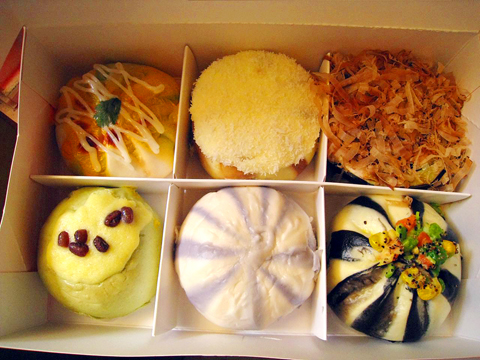Mr Baoz serves variations on the theme of the traditional Chinese pork bun or baozi (包子). The variations are staggering in number and in some cases in conception as well. Who would have imagined a Chinese steamed bun with a strawberry chocolate or an onion and cheese topping? Mr Baoz also goes out of its way to make these buns colorful, so you get the full force of strawberry pink, and yellow cheese is on display even before you take a bite. The effect may be quite off-putting to some, but rest assured that these colorful buns taste better than they look — and to the small children interviewed, they looked pretty good.
Adults who have passed the stage of being enraptured by multicolored food may feel differently, but the buns are cheap, starting at NT$20 for something simple like a steamer butter bun (蒸籠奶黃包), and topping out NT$35 for exotic concoctions such as squid roll buns (墨魚三星卷) or the sweet and sour fish bun (糖醋鮮魚包). Sets of six or a dozen buns are sold at a discount.
The outlet on Guangfu South Road, opposite the Songshan Tobacco Factory (松山菸廠), opened late last year and is the most recent addition to a chain that has stores in Shipai (石牌), on the corner of Tunghua Street (通化街) and on Siping Street (四平街). This outlet itself is remarkably uninspired, having even less charm that a Mr Donut, but the buns themselves are worth a try. They may not, as the takeout menu suggests, “change your lifestyle,” but if you like steamed buns and exotic flavors, you can have quite a lot of fun picking through the 30 or so choices available, or grossing out friends by trying to feed them spicy pork gut or cinnamon pork buns. The Snowflake Series, with taro, peanut, sesame and red bean buns topped with desiccated coconut also looks remarkably revolting, but then, there are people in this world who think Lamington cakes are delicious.

PHOTO: IAN BARTHOLOMEW, TAIPEI TIMES
Personally, this reviewer preferred the aesthetic to the gastronomic aspect of Mr Baoz, finding the buns too soft in the mouth and the flavors somewhat artificial. A short spell in a steamer helps a little, but fundamentally this is food to play with rather than to eat.
Mr Baoz has a flourishing takeout business, and orders can be placed by phone for either hot or frozen delivery. A full menu is also available on the Internet.

US President Donald Trump may have hoped for an impromptu talk with his old friend Kim Jong-un during a recent trip to Asia, but analysts say the increasingly emboldened North Korean despot had few good reasons to join the photo-op. Trump sent repeated overtures to Kim during his barnstorming tour of Asia, saying he was “100 percent” open to a meeting and even bucking decades of US policy by conceding that North Korea was “sort of a nuclear power.” But Pyongyang kept mum on the invitation, instead firing off missiles and sending its foreign minister to Russia and Belarus, with whom it

When Taiwan was battered by storms this summer, the only crumb of comfort I could take was knowing that some advice I’d drafted several weeks earlier had been correct. Regarding the Southern Cross-Island Highway (南橫公路), a spectacular high-elevation route connecting Taiwan’s southwest with the country’s southeast, I’d written: “The precarious existence of this road cannot be overstated; those hoping to drive or ride all the way across should have a backup plan.” As this article was going to press, the middle section of the highway, between Meishankou (梅山口) in Kaohsiung and Siangyang (向陽) in Taitung County, was still closed to outsiders

President William Lai (賴清德) has championed Taiwan as an “AI Island” — an artificial intelligence (AI) hub powering the global tech economy. But without major shifts in talent, funding and strategic direction, this vision risks becoming a static fortress: indispensable, yet immobile and vulnerable. It’s time to reframe Taiwan’s ambition. Time to move from a resource-rich AI island to an AI Armada. Why change metaphors? Because choosing the right metaphor shapes both understanding and strategy. The “AI Island” frames our national ambition as a static fortress that, while valuable, is still vulnerable and reactive. Shifting our metaphor to an “AI Armada”

The Chinese Communist Party (CCP) has a dystopian, radical and dangerous conception of itself. Few are aware of this very fundamental difference between how they view power and how the rest of the world does. Even those of us who have lived in China sometimes fall back into the trap of viewing it through the lens of the power relationships common throughout the rest of the world, instead of understanding the CCP as it conceives of itself. Broadly speaking, the concepts of the people, race, culture, civilization, nation, government and religion are separate, though often overlapping and intertwined. A government